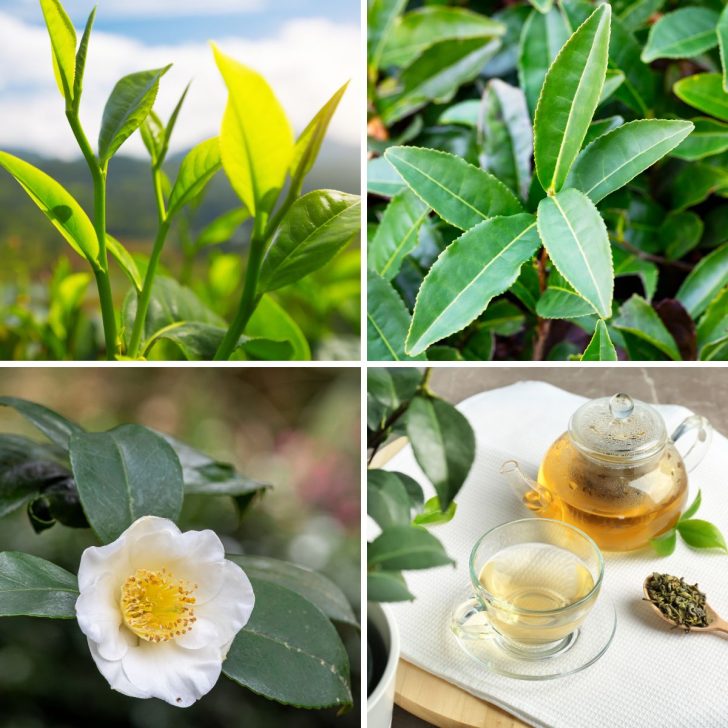If You Love Tea, Grow This Beautiful Bush!
More than just a beautiful flowering bush, the Camellia sinensis tea plant is the botanical source behind the world’s favorite teas, including black, green, oolong, and white teas.
The Camellia sinensis tea plant, a cornerstone of the global tea industry, is renowned for its versatility and the myriad of benefits it offers. Originating from Southeast Asia, this plant has been cultivated across the world, adapting to various climates and growing zones.
Its leaves, which are the primary source of all tea, undergo different processes to yield a range of tea types, including green, black, and oolong. Beyond its culinary uses, the Camellia sinensis tea plant is celebrated for its health benefits, making it a subject of both historical significance and modern scientific research.[1]https://www.ncbi.nlm.nih.gov/pmc/articles/PMC6826564/
Origin
The Camellia sinensis tea plant is believed to have its origins in the regions of Southeast Asia, which includes parts of modern-day China, Tibet, north India, and Myanmar. This area is considered the genetic birthplace of the tea plant, where it has been cultivated for thousands of years.
The Scientific Name and Taxonomic Classification
If you enjoy knowing the hierarchical classifications, Camellia sinensis is classified as follows:
- Kingdom: Plantae
- Clade: Angiosperms
- Clade: Eudicots
- Order: Ericales
- Family: Theaceae
- Genus: Camellia
- Species: C. sinensis
- Genus: Camellia
- Family: Theaceae
- Order: Ericales
- Clade: Eudicots
- Clade: Angiosperms
Camellia Sinensis Growing Zones
Camellia sinensis thrives in tropical and subtropical climates but has been successfully cultivated in temperate zones as well. It prefers regions classified as USDA hardiness zones 7-9, where it can benefit from warm summers and mildish winters.
Beyond that, it simply needs adequate rainfall, well-drained acidic soil, and protection from extreme weather for optimal growth.
Camellia Sinensis Benefits
The health benefits of Camellia sinensis are vast. It is rich in antioxidants such as catechins and flavonoids, which can reduce inflammation, lower the risk of chronic diseases, and improve heart health.
Regular consumption of tea from C. sinensis has been linked to reduced risk of stroke, cancer, and lower blood pressure levels. Additionally, its caffeine and L-theanine content can enhance brain function and improve focus.[2]https://www.ncbi.nlm.nih.gov/pmc/articles/PMC6826564/
Leaves of Camellia Sinensis
The leaves of the Camellia sinensis plant are its most prized asset, harvested to produce tea. These leaves contain a treasure trove of polyphenols, caffeine, and other beneficial compounds.
Depending on the processing method—whether the leaves are oxidized (fermented), withered, rolled, or steamed—the resulting tea can vary significantly in flavor, color, and nutrient content. The method and harvest time also determines whether the end product is a green tea or black tea.
Camellia Sinensis Flowers
The flowers of the Camellia sinensis plant are small, white, and fragrant, with a delicate beauty. While the flowers are often overlooked for the prized leaves forsHowever, they can be used in decorative purposes and occasionally in herbal teas, adding a soft, subtle flavor.
Camellia Sinensis Uses, Parts Used, and Mediums/Solutions of Use
The primary use of the Camellia sinensis plant is in the production of tea, which involves various parts of the plant:
- Leaves: The main component for tea production, used fresh, semi-oxidized, or fully oxidized to create different tea types.
- Buds: Young shoots or tips are often used in high-quality teas, such as green teas, for their delicate flavor and aroma
- Flowers: Occasionally used for their aesthetic appeal and mild flavoring in some herbal tea blends.
The versatility of the Camellia sinensis tea plant extends beyond its consumption, with research exploring its potential in cosmetics and pharmaceuticals, capitalizing on its antioxidant properties.
We love to be able to grow our own food, supplements and medicine. With the Camellia sinensis tea plant, you have both, enjoyable refreshment in the way of hot or cold tea as well as proven health benefits.
While not as commonly used as Camellia sinensis, we also love growing and using Camellia sasanqua as an ornamental bush that can also be used for delicious and beneficial tea.

I’m LeAura Alderson, a garden, herb and plant enthusiast with a passion for discovering the many edible and medicinal benefits of the plants all around us, including the weeds! I’m a writer, editor and media publisher for our family of websites.
While I was certified in fitness and life coaching, I am NOT a health practitioner. However, I’m a lifelong health enthusiast, with a keen interest in healthy, organic foods and making home remedies and the content we share is from our own experience and usage as well as that extracted from scientific research so that you can explore further on your own.
Always seek the advice and guidance of your health practitioners first and foremost.
As a family we’re steadily expanding our gardening, experimentation and knowledge around all things gardening, edible landscaping, fresh organic foods and self sustainability with farming in our future. I also own and manage iCreateDaily.com, a site all about transformation through creation, and the power of positivity, optimism and mindset.
References

